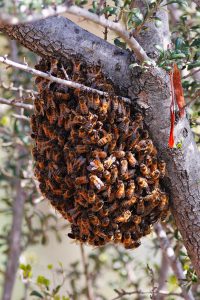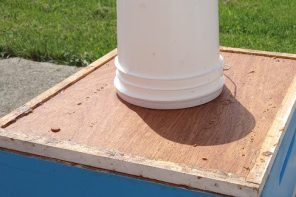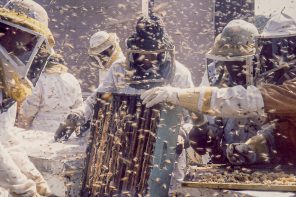From the Editor
By: Jerry Hayes
 TREATING WITH ANTIBIOTICS AND VFD
TREATING WITH ANTIBIOTICS AND VFD
QUESTION
I am a backyard beekeeper. My state inspector came out and looked at my colonies and said I needed to treat with terramycin. I told her I did not have a veterinarian that knew about honey bees so I could get an antibiotic legally through the Veterinary Feed Directive (VFD). She said go ahead and ignore the VFD as terramycin was going to be discontinued anyway. I looked up the FDA Veterinary Feed Directive online and I don’t think ignoring the VFD is a good idea.
Anonymous
ANSWER
Short answer is I am not a veteriarian nor have I ever played one on TV. The VFD was put in place to stop the cavalier use of antibiotics in animals, honey bees included, and stop or at least slow down the growth of antibiotic resistant bacteria, keep our food supply safe and bring in animal medical expertise to our industry. So, do not access or use a product illegally in your honey bee colonies.
On the flip side, I can count the number of veterinarians who know anything about honey bees, pests, parasites and diseases on one hand. There is a great organization that is trying to improve this, the Honey Bee Veterinary Consortium (HBVC). I Googled them up at https://www.hbvc.org/. On the site there is a link to Find a Vet. And in Bee Culture we have Dr. Tracy Farone and her column Bee Vet.
All this to say, you should set the standard in your state with beekeepers and the state inspector to the best of your ability regardless of how awkward it may seem at first as this veterinarian/beekeeper partnership evolves.
NOW WHAT DO I DO?
QUESTION
Spring has finally come to us in the North. It took all Winter though. Ugh. This is my second year. I had two colonies in October and on a warm day last week, I saw bees flying from one of them. What should I do now?
Marceline Roush
ANSWER
Well, you only had a 50% loss which is unfortunately semi-normal. But it can be better.
Here is my list:
- I hope you are a member of your local beekeeper club. If not join, then ask for mentoring help. The mentor needs to have five plus years of SUCCESSFUL beekeeping. It takes a minimum of five years to be a humble enough beekeeper to help others.
- On the next warm, sunny, 60°F day you and your experienced mentor open the colony for a thorough inspection.
- How many frames of bees are there? Do they have enough stored honey or do they need feeding? Are there eggs, larvae, capped brood? Is the brood healthy? Are there enough bees to support brood rearing? If not, is there a queen? If no queen, has the colony progressed to laying workers? What does comb look like light, dark? Drone cells? And many more things your mentor can point out.
- Go to the Honey Bee Health Coalition website, https://honeybeehealthcoalition.org/ There is all the info you need for successful Varroa control and brood diseases in the Tools for Varroa Management Guide. I suggest memorizing it.
- There are other questions as you learn that managing honey bees is a visual sport. Learning what to look for and then the comparison and contrast of what you are seeing is critical.
- Remember with Varroa and the Varroa virus legacy, you have to be the responsible manager of these animals. If not, don’t be a beekeeper.
TROPILAELAPS MITE
QUESTION
What is the Tropilaelaps mite exactly? I heard about it as another honey bee mite problem.
Clevon Morgan
ANSWER
Let’s step back for a moment. First, how did we get Varroa mites? Varroa was found in Florida in 1987. How it got there is still unclear. Was it in a swarm of Varroa infested bees on a ship or plane or did somebody sneak a queen in with Varroa? I mention this because with our global economy, anything can show up on our doorstep from anywhere in the world. A recent example is COVID.
What is Tropilaelaps is a great question. Google is an amazing resource… https://entnemdept.ufl.edu/creatures/MISC/BEES/Tropilaelaps.htm. This link is from the UF/IFAS website and ‘Featured Creatures’. See some highlights I picked out below for Distribution and Life Cycle:
Distribution
Tropilaelaps is a native pest in tropical and subtropical Asia. However, Tropilaelaps’ distribution has been expanding over the past 50 years. Tropilaelaps can been found in Apis mellifera colonies well beyond the mite’s native range. Invasive Tropilaelaps populations are most successful in warm environments where honey bees produce brood (developing larvae or pupae) throughout the year. For instance, Tropilaelaps have been reported in Kenya and Papua New Guinea.
Life Cycle
Tropilaelaps have small mouth parts that are unable to pierce the integument (skin) of adult honey bees. Therefore, both nymph and adult Tropilaelaps must feed on the hemolymph of the honey bee brood. After emerging from the honey bee brood cell, adult Tropilaelaps must re-enter another brood cell to feed on a developing bee or the mite will die within two days. Tropilaelaps have a short reproductive cycle and possess the potential for rapid population growth. Furthermore, their rapid reproduction enables Tropilaelaps to out compete Varroa in honey bee colonies infected by both mites.
Because of global trade, Tropilaelaps will continue to spread and take reproductive advantage in managed honey bee colonies around the world. One of the concerns I have heard is that one of our neighboring country’s is/has been bringing in packages from Australia. The tip of Australia is approx. 93 miles from Papua New Guinea. And as you know, Australia now has Varroa which was found at a port location. All that to say, get ready.
 STOP SWARMING
STOP SWARMING
QUESTION
How can I stop some of my colonies from swarming?
S. Archibald
ANSWER
Why do honey bees swarm is the real question? Our honey bees figured out long ago that in order to simply survive they had to divide and conquer by spreading their genetics around. One colony staying in one location was genetic survival disaster. Most of our honey bees have genetics from where they survived a long, cold, hard northern Europe Winter. Our honey bees are always preparing for Winter. Many places in the U.S. have Spring upon us now. Honey bees now have a few months to build up, reproduce by dividing up the colony, have that ‘other’ group of honey bees (a swarm) find another cavity in a tree or wall of a house or collected by a beekeeper and put in a box to establish a colony, build comb, collect nectar, beebread, build up a population that can maintain a temperature to make to through an Ohio, Alabama, Kansas, North Dakota, etc. Winter. Stopping, preventing, slowing this swarming survival genetically imprinted goal is almost impossible. This is like trying to stop _____ (fill in the blank). All that to say if researchers developed a genetically modified honey bee that didn’t swarm and left long term consistent management up to us beekeepers, they would disappear like the dinosaurs did. They are survivors because of genetic diversity and they are in fact, managing us beekeepers to keep them alive and healthy so they can swarm, not the other way around.








